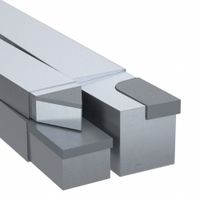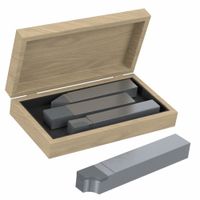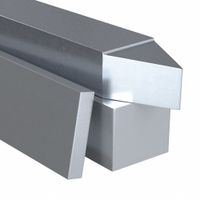Call +(254) 703 030 000 / 751 483 999 / 721 704 777
- Home
- Machining
- Turning Boring Grooving
- Lathe Tool Bits Blanks Sets
.....Read More
Frequently Asked Questions
What are the different types of lathe tool bits?
Lathe tool bits are essential components used in machining operations to shape and cut materials. They come in various types, each designed for specific tasks:
1. **Turning Tool Bits**: Used for reducing the diameter of a workpiece. They can be further classified into roughing and finishing tools, where roughing tools remove large amounts of material, and finishing tools provide a smooth surface.
2. **Facing Tool Bits**: Designed to cut a flat surface perpendicular to the workpiece's axis. They are used to create a smooth, flat face on the end of the workpiece.
3. **Parting Tool Bits**: Also known as cutoff tools, these are used to cut off parts of the workpiece. They have a narrow blade to minimize material waste.
4. **Threading Tool Bits**: Used to cut threads on the workpiece. They have a specific profile to match the thread form being cut, such as V-shaped or square.
5. **Boring Tool Bits**: Used to enlarge or finish the inside diameter of a hole. They are typically used after drilling to achieve precise dimensions and finishes.
6. **Grooving Tool Bits**: Designed to cut grooves or recesses in the workpiece. They are similar to parting tools but are used to create grooves rather than cut off sections.
7. **Knurling Tool Bits**: Used to create a textured pattern on the surface of the workpiece, often for grip. They consist of hardened rollers with the desired pattern.
8. **Forming Tool Bits**: Used to create specific shapes or profiles on the workpiece. They are custom-made to match the desired contour.
Each type of tool bit is made from materials like high-speed steel, carbide, or ceramics, chosen based on the material being machined and the desired finish. Proper selection and use of these tool bits are crucial for efficient and accurate machining operations.
How do I choose the right lathe tool bit for my project?
To choose the right lathe tool bit for your project, consider the following factors:
1. **Material of Workpiece**: Match the tool bit material to the workpiece. Use high-speed steel (HSS) for softer materials like aluminum, and carbide for harder materials like stainless steel.
2. **Type of Operation**: Determine the operation type—turning, facing, threading, or parting. Each requires a specific tool bit shape and angle.
3. **Tool Bit Shape**: Select the shape based on the operation. Common shapes include round, square, and diamond. For general turning, a square or round shape is versatile.
4. **Tool Bit Size**: Ensure the tool bit size fits your lathe tool holder and is appropriate for the workpiece size. Larger workpieces may require larger tool bits for stability.
5. **Cutting Angle**: Choose the correct cutting angle for the material and operation. Positive rake angles are suitable for softer materials, while negative rake angles are better for harder materials.
6. **Tool Bit Coating**: Consider coated tool bits for increased durability and performance. Coatings like titanium nitride (TiN) reduce friction and wear.
7. **Feed and Speed Requirements**: Match the tool bit to the lathe’s feed and speed capabilities. Carbide can handle higher speeds, while HSS is better for slower operations.
8. **Finish Quality**: For a smoother finish, select a tool bit with a fine cutting edge and appropriate nose radius.
9. **Cost and Availability**: Balance cost with performance needs. Carbide is more expensive but lasts longer, while HSS is cheaper and easier to sharpen.
10. **Experience and Skill Level**: Beginners may prefer HSS for its ease of use and sharpening, while experienced machinists might opt for carbide for efficiency.
By considering these factors, you can select the most suitable lathe tool bit for your specific project needs.
What materials are lathe tool bits made from?
Lathe tool bits are made from a variety of materials, each chosen for specific properties that suit different machining tasks. The most common materials include:
1. **High-Speed Steel (HSS):** Known for its toughness and ability to withstand high temperatures without losing hardness, HSS is widely used for general-purpose machining. It is cost-effective and can be easily sharpened.
2. **Carbide:** Composed of tungsten carbide particles bonded with a metal, usually cobalt, carbide tool bits are extremely hard and wear-resistant. They maintain their cutting edge at higher temperatures, making them suitable for high-speed operations and cutting hard materials.
3. **Cobalt Steel Alloys:** These are variations of HSS with added cobalt, enhancing their heat resistance and hardness. They are used for cutting tougher materials and in applications where higher cutting speeds are required.
4. **Ceramics:** Made from aluminum oxide or silicon nitride, ceramic tool bits are extremely hard and can operate at very high speeds. However, they are brittle and more suited for finishing operations on hard materials.
5. **Cermets:** A combination of ceramic and metallic materials, cermets offer a balance between toughness and hardness. They are used for high-speed finishing operations and provide excellent surface finishes.
6. **Diamond:** Both natural and synthetic diamonds are used for cutting non-ferrous metals and abrasive materials. Diamond tool bits offer the highest hardness and wear resistance but are expensive and not suitable for ferrous materials due to chemical reactions at high temperatures.
7. **Cubic Boron Nitride (CBN):** Second only to diamond in hardness, CBN is used for cutting hard ferrous materials. It offers excellent thermal stability and wear resistance.
Each material has its advantages and limitations, and the choice depends on the specific requirements of the machining operation, including the material being cut, the desired finish, and the production speed.
How do I sharpen lathe tool bits?
To sharpen lathe tool bits, follow these steps:
1. **Safety First**: Wear safety goggles and gloves. Ensure the grinder is securely mounted and the work area is clear.
2. **Tool Selection**: Choose the appropriate grinding wheel. Aluminum oxide wheels are suitable for high-speed steel, while silicon carbide wheels are better for carbide tools.
3. **Tool Rest Adjustment**: Set the tool rest on the grinder to about 10-15 degrees for the initial grinding angle. Ensure it is stable and at the correct height.
4. **Initial Grinding**: Hold the tool bit firmly with both hands. Start with the side cutting edge. Position the tool bit at the desired angle against the wheel. Use a back-and-forth motion to grind evenly. Maintain a consistent angle to form the primary cutting edge.
5. **Forming the Relief Angles**: Adjust the tool rest to grind the side and end relief angles. Typically, side relief is around 8-12 degrees, and end relief is about 5-8 degrees. Grind these angles carefully to ensure proper clearance.
6. **Nose Radius**: Round the tip of the tool bit slightly to form a nose radius. This helps in achieving a smoother finish on the workpiece.
7. **Finishing Touches**: Use a fine-grit wheel or a honing stone to refine the cutting edge. This step removes burrs and sharpens the edge further.
8. **Cooling**: Frequently dip the tool bit in water to prevent overheating, which can damage the tool's temper.
9. **Inspection**: Check the tool bit for sharpness and correct angles. Adjust if necessary.
10. **Testing**: Test the sharpened tool bit on a piece of scrap material to ensure it cuts efficiently.
By following these steps, you can effectively sharpen lathe tool bits, ensuring optimal performance and longevity.
What is the difference between HSS and carbide lathe tool bits?
High-Speed Steel (HSS) and carbide lathe tool bits differ primarily in composition, performance, and application:
1. **Composition**:
- **HSS**: Made from a combination of steel with elements like tungsten, molybdenum, chromium, and vanadium. It is known for its toughness and ability to withstand high temperatures without losing hardness.
- **Carbide**: Composed of tungsten carbide particles bonded with a metal, usually cobalt. It is much harder than HSS and retains its hardness at higher temperatures.
2. **Performance**:
- **HSS**: Offers good toughness and is less brittle, making it suitable for interrupted cuts and applications requiring resilience. It is ideal for general-purpose machining and can be easily sharpened.
- **Carbide**: Provides superior hardness and wear resistance, allowing for higher cutting speeds and longer tool life. It is excellent for high-speed applications and machining hard materials but is more brittle than HSS.
3. **Application**:
- **HSS**: Used for a wide range of materials, including softer metals like aluminum and mild steel. It is preferred for manual or low-speed operations and where tool cost is a concern.
- **Carbide**: Best suited for high-speed, high-volume production environments and machining hard materials like stainless steel and cast iron. It is often used in CNC machines for precision and efficiency.
4. **Cost**:
- **HSS**: Generally less expensive, making it a cost-effective choice for small-scale operations or where frequent tool changes are needed.
- **Carbide**: More expensive due to its superior performance and longevity, but cost-effective in high-production settings due to reduced downtime and tool changes.
In summary, HSS is favored for its toughness and versatility, while carbide is chosen for its hardness and efficiency in demanding applications.
How do I set up a lathe tool bit for cutting?
To set up a lathe tool bit for cutting, follow these steps:
1. **Select the Tool Bit**: Choose the appropriate tool bit material (e.g., high-speed steel, carbide) and shape (e.g., right-hand, left-hand, or neutral) based on the material being machined and the type of cut (e.g., facing, turning).
2. **Tool Bit Grinding**: If necessary, grind the tool bit to the desired shape. Ensure the correct angles:
- **Rake Angles**: Adjust the back rake and side rake angles for efficient chip removal.
- **Clearance Angles**: Set the end relief and side relief angles to prevent rubbing against the workpiece.
- **Nose Radius**: Grind a small radius on the tool tip for a smoother finish.
3. **Tool Post Setup**: Secure the tool bit in the tool holder, ensuring it is tightly clamped. Insert the tool holder into the tool post on the lathe.
4. **Center Height Adjustment**: Adjust the tool bit to the center height of the lathe spindle. Use a center gauge or a ruler to align the tool tip with the lathe center. This prevents tapering and ensures accurate cuts.
5. **Tool Overhang**: Minimize the overhang of the tool bit from the tool holder to reduce vibration and increase stability.
6. **Tool Angle Positioning**: Position the tool bit at the correct angle relative to the workpiece. For turning, the tool should be perpendicular to the workpiece. For facing, the tool should be parallel to the workpiece face.
7. **Secure Workpiece**: Mount the workpiece securely in the lathe chuck or between centers, ensuring it is properly aligned and balanced.
8. **Check Clearances**: Ensure there is adequate clearance between the tool bit and the workpiece before starting the lathe.
9. **Test Cut**: Perform a test cut to verify the setup, making adjustments as necessary for optimal performance.
What are the best practices for maintaining lathe tool bits?
1. **Regular Inspection**: Frequently check tool bits for wear, damage, or dullness. Replace or sharpen as needed to maintain cutting efficiency.
2. **Proper Sharpening**: Use the correct grinding wheel and technique to sharpen tool bits. Maintain the original geometry and angles to ensure optimal performance.
3. **Correct Storage**: Store tool bits in a dry, organized environment to prevent rust and damage. Use protective cases or racks to avoid accidental chipping.
4. **Appropriate Use**: Use tool bits for their intended materials and applications. Avoid using a tool bit designed for soft materials on harder materials, as this can cause premature wear.
5. **Lubrication and Cooling**: Apply appropriate cutting fluids to reduce heat and friction during operation. This extends the life of the tool bit and improves the quality of the cut.
6. **Proper Mounting**: Ensure tool bits are securely mounted in the tool holder. Misalignment can lead to poor performance and increased wear.
7. **Controlled Cutting Speeds**: Operate at recommended speeds and feeds for the material being machined. Excessive speed can cause overheating and rapid tool wear.
8. **Regular Cleaning**: Clean tool bits after use to remove debris and cutting fluids. This prevents corrosion and maintains cutting efficiency.
9. **Avoid Overloading**: Do not apply excessive force or depth of cut, as this can lead to tool breakage or rapid wear.
10. **Training and Safety**: Ensure operators are trained in proper tool handling and maintenance procedures to prevent accidents and prolong tool life.


